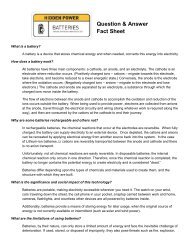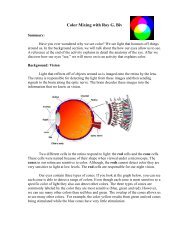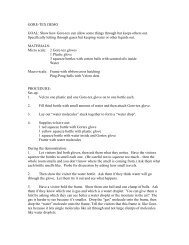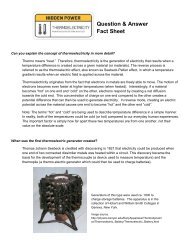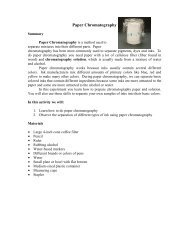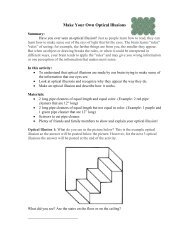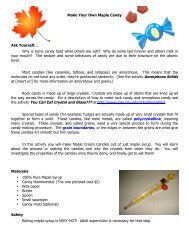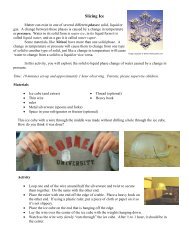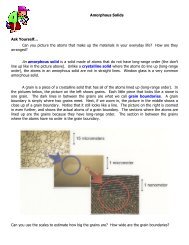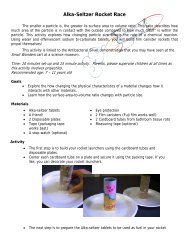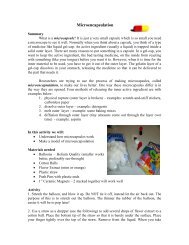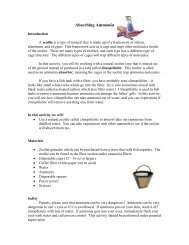Executive Summary Final - the Center for Nanoscale Science - an ...
Executive Summary Final - the Center for Nanoscale Science - an ...
Executive Summary Final - the Center for Nanoscale Science - an ...
You also want an ePaper? Increase the reach of your titles
YUMPU automatically turns print PDFs into web optimized ePapers that Google loves.
IRG2: Powered Motion at <strong>the</strong> <strong>N<strong>an</strong>oscale</strong><br />
A third area of research has been <strong>the</strong> optical<br />
control of motor behavior: <strong>the</strong> combined<br />
operation of cyclic chemical reactions <strong>an</strong>d<br />
propulsive motion in coupled populations of Ag/<br />
AgCl particles that engage in periodic clumping<br />
<strong>an</strong>d explosion in a complex non-linear fashion,<br />
with nearby clusters dynamically triggering <strong>the</strong><br />
explosions of nearby clusters in novel reaction<br />
waves of a mixed character: part homogeneous<br />
solution <strong>an</strong>d part particle-surface mediated. The<br />
figure at right – which depicts <strong>the</strong> probability that<br />
a cluster will explode given that a cluster has<br />
previously exploded a dist<strong>an</strong>ce R away at <strong>the</strong><br />
specified time in <strong>the</strong> past, provides proof of<br />
cluster-cluster interaction: <strong>the</strong> peak <strong>for</strong> a 0.2 s delay at around 20 microns clearly indicates<br />
cluster-cluster correlations. The overlap of ion gradients of nearby particles produces a<br />
particularly strong motor-motor coupling in <strong>the</strong>se systems, with enticing prospects to exhibit<br />
collective behaviors including particle-reaction waves, bistability, etc.<br />
In <strong>the</strong> catalytic motor are as a whole, in 2010 we have discovered <strong>the</strong> first examples of n<strong>an</strong>o/<br />
micro-objects outside living systems that move autonomously by converting chemical energy<br />
into mech<strong>an</strong>ical <strong>for</strong>ces. With very little “in<strong>for</strong>mation” input (in <strong>the</strong> <strong>for</strong>m of gradients), <strong>the</strong>se<br />
objects begin to display emergent collective behavior that were thought to lie solely in <strong>the</strong> realm<br />
of biology. Freed of usual biological constraints, we now have <strong>the</strong> unprecedented opportunity to<br />
probe <strong>the</strong> ultimate limits of self-org<strong>an</strong>ization in <strong>the</strong>se dynamic systems that operate far from<br />
equilibrium. Our eventual goal is to develop “intelligent” n<strong>an</strong>o/microbots that c<strong>an</strong> sense <strong>the</strong>ir<br />
environment, communicate <strong>the</strong> in<strong>for</strong>mation to o<strong>the</strong>r bots, <strong>an</strong>d induce swarming behavior in<br />
heterogeneous populations of <strong>the</strong>se bots to produce pre-determined functional outcomes.<br />
At smaller length scales, molecular motors designed to exhibit controlled mech<strong>an</strong>ical motions<br />
on <strong>the</strong> molecular scale present promising possibilities of building novel functional materials <strong>an</strong>d<br />
to extend ideas of catalytically-powered motion – already developed in solution on <strong>the</strong> singlemolecule<br />
level in <strong>the</strong> work described above – to molecular systems that are harnessed to<br />
substrates or within active materials. Our research in molecular motors aims towards assembling<br />
various single-molecule motors in well-defined n<strong>an</strong>oscale assemblies on surfaces to induce<br />
controlled motion with light, electrons, <strong>an</strong>d ions, <strong>an</strong>d to harness <strong>the</strong>se motions towards<br />
applications in n<strong>an</strong>o-electro-mech<strong>an</strong>ical systems <strong>an</strong>d n<strong>an</strong>ophotonics.<br />
As with catalytic motors, we have had several signific<strong>an</strong>t accomplishments in molecular motors<br />
project over <strong>the</strong> past year. First, we have discovered that <strong>the</strong> structure of specially designed<br />
rotax<strong>an</strong>e molecules c<strong>an</strong> be ch<strong>an</strong>ged reversibly between two (or more) stable states by employing<br />
a redox reaction. We used <strong>the</strong> n<strong>an</strong>oscale motion induced within <strong>the</strong> molecule to generate<br />
microscale motions by arr<strong>an</strong>ging <strong>the</strong>m to work in unison. In order to control <strong>the</strong> motion <strong>an</strong>d<br />
orientation, we also studied <strong>the</strong> con<strong>for</strong>mational ch<strong>an</strong>ges in rotax<strong>an</strong>es at <strong>the</strong> single-molecule level<br />
<strong>an</strong>d observed that con<strong>for</strong>mational ch<strong>an</strong>ges correlate with <strong>the</strong> known redox states of rotax<strong>an</strong>es.



